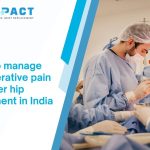Deciding to have a hip replacement is a courageous decision that promises relief from years of chronic, debilitating pain. However, it is perfectly normal to feel anxiety about the acute post-operative pain that follows. The truth is, the most successful recoveries are those where pain management is prioritized aggressively and proactively.
In India, where healthcare standards are rapidly advancing and hospital stays are typically short, the responsibility for managing your comfort transitions quickly to you and your dedicated family caregivers at home. This guide will walk you through the advanced strategies employed by surgeons, and the practical steps you must take to ensure effective, comfortable pain management throughout your entire hip replacement journey, from the operating room to full recovery.
The Modern Philosophy of Pain Management
The current global standard for surgical pain management is called Multi-Modal Analgesia. This approach is crucial for controlling post-operative pain effectively. Instead of relying heavily on a single drug (like traditional high-dose opioids), this strategy uses a combination of medications that work through different pathways in the nervous system to block pain signals before they even start.
1. Pre-emptive Analgesia
The goal here is to prevent the nervous system from getting hyper-sensitized during surgery. Often, pain medication is administered before the incision is even made. This might include:
- Gabapentinoids: Medications like Pregabalin or Gabapentin are sometimes given the night before or the morning of surgery. They quiet the nerve pathways, reducing the intensity of the post-operative pain signals.
- NSAIDs/Acetaminophen: Non-steroidal anti-inflammatory drugs (NSAIDs) or Paracetamol (Acetaminophen) are given to begin reducing inflammation and fever before the trauma of surgery starts.
2. Peripheral Nerve Blocks (PNBs)
This is a game-changer for pain management. An anesthetist administers a local anesthetic injection near the major nerves that supply the hip joint (often the femoral nerve or nerves around the hip capsule).
- Benefit: This provides profound numbness to the surgical area, offering several hours (sometimes up to 24 hours) of nearly complete post-operative pain relief immediately after the procedure. This “head start” allows the patient to begin crucial early mobilization and physical therapy without the crushing initial pain.
3. Intra-operative Injections
Your surgeon often injects a long-acting cocktail of local anesthetic and anti-inflammatory drugs directly into the tissues around the new joint before closing the incision. This direct infiltration provides localized pain management that can last for hours, further contributing to a comfortable emergence from anesthesia.
💪 Regain Your Freedom — Move Without Hip Pain Again!
Thinking about Hip Replacement Surgery? Understand the full journey — from preparation to recovery — and learn how our experts help you walk pain-free again with personalized care and faster healing.
🏥 Schedule Your Free Hip Surgery Consultation✔ Meet top orthopedic surgeons | ✔ 3D implant options | ✔ Faster recovery programs
⚡ Only a few free consultation slots left this week — book now!
Section 2: The Hospital Phase in the Indian Context
Hospital stays for hip replacement in India are generally efficient, often lasting between 3 to 5 days, depending on your physical therapy progress. The focus during this phase is transitioning you from continuous, IV or PNB-based pain management to a reliable oral medication regimen.
1. The Scheduled Medication Protocol
In the hospital, medication is administered on a strict, scheduled basis, regardless of whether you feel pain at that exact moment. This is paramount to preventing pain flares. Your medication cocktail will typically include:
- Paracetamol (Acetaminophen): A non-opioid staple baseline pain relief.
- NSAIDs (e.g., Etoricoxib, Celecoxib): Used to combat inflammation, given twice daily (unless you have a medical contraindication like a severe ulcer or kidney issue).
- Mild Opioids (e.g., Tramadol, Tapentadol): Used for moderate pain and as a bridge during the first few days.
- Breakthrough Pain Medication: A stronger, fast-acting opioid (often available in tablet form) to be taken only when scheduled doses aren’t enough—this is your rescue dose.
Do not wait for the pain to become severe before requesting medication. If you feel the scheduled medication is wearing off. This proactive approach ensures better post-operative pain control.
Section 3: Transitioning to Home Care and Rehabilitation in India
The true test of effective pain management happens when you are discharged. The rapid mobilization protocols mean you will be doing challenging physical therapy at home or at an outpatient center in India. Pain is a natural part of challenging the joint, but it must be controlled to allow for proper exercise.
1. Tailoring the Oral Regimen
Your surgeon will transition you to a clear, written schedule for your oral medications. This regimen must be followed strictly, especially in the first two weeks at home.
- Tapering Strategy: The goal is to taper off the opioid component as quickly as possible while relying on the anti-inflammatory and non-opioid medications. You may continue Paracetamol and NSAIDs.
- Opioid Management in India: There is often a stigma or reluctance to use opioids. If your surgeon prescribes them, they are necessary for functional recovery. Take them as prescribed, but work diligently with your doctor to stop them promptly when the acute post-operative pain subsides. Never share these medications.
2. The Relationship Between Pain and PT
Physical therapy is non-negotiable for a successful hip replacement recovery. However, therapy often causes temporary pain flares. This is normal.
- Pre-Dosing: Always take your scheduled pain medication approximately $30$ to $45$ minutes before your physical therapy session begins. This ensures the medication is active during the most challenging part of your day, allowing you to get the most out of your exercises.
- The “Good Pain” Rule: You should feel discomfort during exercise, but it should not be agonizing or persist for hours afterwards. If your pain is a $6/10$ or higher during PT, you need to discuss this with your therapist and potentially your surgeon to adjust the intensity or your medication dose.
3. Unique Home Care Logistics in India
In a typical India home setting, you may have more dedicated family support, which can be an immense advantage. Utilize this support:
- Mobility Support: Ensure your family is trained to help you safely use crutches or a walker. Reducing the fear of falling significantly reduces pain-related anxiety.
- Bed Setup: Ensure your bed is at a height that allows you to sit with your knees lower than your hips to adhere to post-operative precautions (if necessary for your surgical approach). Have all necessary items (phone, water, remote, medications) within arm’s reach to minimize unnecessary reaching or twisting.
Section 4: Non-Pharmacological Pain Relief Strategies
Medications are only one part of the effective pain management strategy. These simple, non-drug techniques are particularly accessible and effective in the Indian home environment and can significantly improve hip replacement outcomes.
1. Cold Therapy (Icing)
Icing is incredibly effective for managing localized swelling and inflammation, which are major contributors to post-operative pain.
- Protocol: Apply an ice pack (or a bag of frozen peas wrapped in a thin towel) to the hip and groin area.
- Timing: Use it immediately after every physical therapy session, and frequently throughout the day, especially before attempting sleep.
2. Elevation and Rest
Elevating your leg slightly (using pillows under the calf, ensuring the heel is not resting directly on the pillow) when resting helps the body remove fluid and swelling from the limb, which directly reduces pressure and pain. Pacing your activity—alternating short walks with rest periods—is far superior to pushing through prolonged activity and then suffering a severe pain rebound.
3. Distraction and Mental Health
Pain is not just physical; it has a significant psychological component. Anxiety, fear, and boredom can magnify the perception of post-operative pain.
- Mind-Body Techniques: Simple breathing exercises, listening to music, watching movies, or reading can divert your attention from the discomfort.
- Consistency: Focus on small victories. Acknowledging that you walked an extra $5$ meters today, or that your sleep was better, reinforces positive mental health, which is a powerful tool for pain management.
Section 5: Dealing with Breakthrough and Chronic Pain
Effective pain management means that you feel comfortable enough to function. It does not mean zero pain. If you experience unexpected, severe pain, it’s called breakthrough pain.
- Action Plan: If you experience breakthrough pain, take your designated rescue medication. Wait 30 minutes. If the pain is still unacceptable, call your surgical team. Do not attempt to take an extra dose of your scheduled medication without guidance, especially with opioids.
- Warning Signs: While some post-operative pain is normal, severe, unexplained pain coupled with red flags is not. Immediately contact your doctor if you experience:
- Pain that suddenly spikes and is unrelieved by medication.
- Fever or chills.
- New or severe swelling, especially in the calf (a sign of Deep Vein Thrombosis).
- Redness, excessive warmth, or pus draining from the incision (a sign of infection).
In conclusion, a successful and comfortable hip replacement recovery, particularly in the home setting in India, depends on a disciplined, proactive approach to pain management. By combining the power of multi-modal, scheduled pharmaceuticals with the consistent application of non-drug therapies like icing and pacing, you gain control over your recovery. The dedicated surgeons at Impact Ortho are experts in utilizing the latest ERAS protocols to minimize your post-operative pain and ensure your swift return to mobility. For precision hip replacement surgery and comprehensive recovery planning, trust the team at Impact Ortho to guide you every step of the way.
💪 Recover Faster — Manage Hip Surgery Pain the Right Way!
Want to know the **best ways to reduce pain after Hip Replacement Surgery in India?** Learn expert-approved pain control methods, exercises, medications, and recovery routines that help you heal comfortably and regain mobility quickly.
🏥 Talk to an Expert About Post-Surgery Pain Relief✔ Personalized pain-management plan | ✔ Safe recovery guidance | ✔ Faster mobility tips
⚡ Limited expert consultation slots available — book today!
Frequently Asked Questions (FAQs)
Is it normal to have pain that wakes me up at night?
Yes, it is very common, particularly in the first few weeks. When you lie still, blood flow slows down and the effects of gravity change, which can increase swelling and pain. Always take your pain medication right before bed, and use cold therapy for 15 minutes before trying to sleep. Sleeping on your back with a pillow between your knees (if comfortable) is usually the best position.
Should I continue taking my regular arthritis medications after surgery?
You must discuss this with your surgeon. They will usually instruct you to temporarily stop all blood-thinning medications and often even your regular NSAIDs a week before surgery. After the operation, they will advise you on exactly when to restart your chronic medications. Paracetamol and selective NSAIDs are generally safe post-operatively.
Why do I feel pain down my thigh or knee after hip replacement?
This is known as referred pain, and it is common. The hip, thigh, and knee share some of the same nerve pathways. As your body heals, the nerves can sometimes misinterpret where the pain is coming from. If the new hip joint alignment is excellent (which is the goal), this referred pain usually resolves within the first few weeks or months.
How long does the swelling and bruising last?
Significant swelling and bruising around the hip and down the thigh, often extending to the knee, is completely normal. The peak swelling usually occurs around days 3 to 5 post-operative. It can take 6 weeks to 3 months for all bruising and residual swelling to fully resolve. Consistent elevation, gentle calf pumps, and icing are the best ways to speed up this process.
When can I safely stop taking opioid pain medication?
The goal is to stop taking opioids as soon as possible, usually within 1 to 3 weeks. You are ready to stop when you are comfortable using only Paracetamol (Acetaminophen) and your NSAID (if prescribed) for 24 hours straight, and your pain level remains consistently below 4/10. When you stop, it’s best to discuss a tapering schedule with your doctor rather than stopping abruptly.
What if my family struggles to find the prescribed medications in my local area in India?
The most critical medications (Paracetamol, NSAIDs, and common mild opioids) are generally available across reputable pharmacies in India. If a specific brand is unavailable, contact your surgical team immediately. They can provide an alternative generic name or a therapeutic substitute to ensure there is no gap in your crucial pain management schedule.











